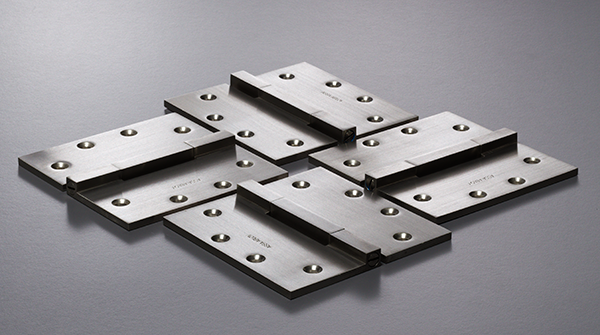Everything you need to know about Commercial Door Hinges: What Is a Commercial Door Hinge?

Commercial door hinges are thicker gauge, load-bearing hardware that lasts for years. The construction and purpose of the door hinge is particularly important when considering what door hinge to use as well.
Ranging in size and configuration, a typical size for a commercial butt hinge is 4 ½” by 4 ½” with a ⅛” thickness and 1⁄2” diameter. The corners are typically square. They are larger than average hinges because they must handle more wear and tear over a longer period of time and perform under weight, stress and surrounding environment. This heavy duty hardware comes in a variety of finishes, but stainless steel is considered a superior material.
Ball-bearing hinges are one of the most common types found in commercial use. These hinges prevent some of the heavy door problems that occur with long-term use in offices, hospitals, and industrial buildings. These lubricated bearings allow for smooth and silent operation with long-lasting and reliable operation for heavy, wide doors or exterior doors.
Hinges: Residential vs Commercial
When it comes to hinges, you still find decorative, bronze and wrought iron hinges that make a home’s doors look like pieces of art rather than the industrialized, thick hinges used in commercial operations. However, the main difference is the spring tension that is optimized for door performance and long-lasting use in industrialized spaces.
However, if a residential door is considerably wider or heavier, then a commercial door hinge or at least a larger decorative hinge may be considered.
In comparison to commercial door hinges, residential hardware is much smaller, typically measuring 3 ½” by 3 ½” in size and 1/16” in thickness with a knuckle diameter of ⅜”, and a radius corner is commonly used.
Another difference is the screw hole design. Residential hinges have a “W” pattern for their screw holes, while others are more unique. However, that’s not the case for commercial door hinge designs, which must use a semi-circle or curved half-moon shape in many cases. While this was not always standard, it was established to maintain uniform load-bearing designs for commercial doors, hinges, and frames.
Architectural Hinges
Within commercial hinge hardware, there are thicker gauge designs called architectural hinges that are used when a door is much heavier. These can be used for commercial or residential purposes, but the main difference is that architectural hinges use higher-grade materials to withstand constant strain on a swinging heavy door.
For commercial doors, these hinges are made with ball bearing hinges because of their frequent use, which needs to be free of friction typically for 1,000,000 life cycles or more.
Industrial Hinges
Industrial door hinges are simply built differently. They are designed with better materials for immense load-bearing. In addition, they are typically custom-made for the type of frame and door needed. They can withstand additional stress, weight, and high-velocity use. They are also typically made in metal finishes.